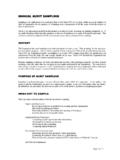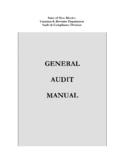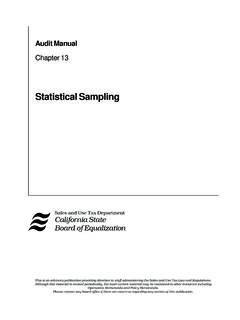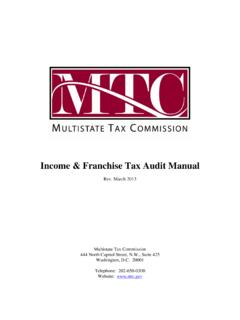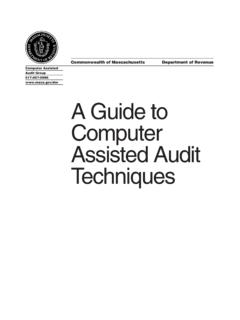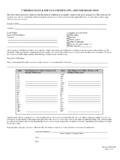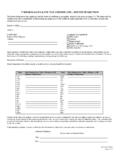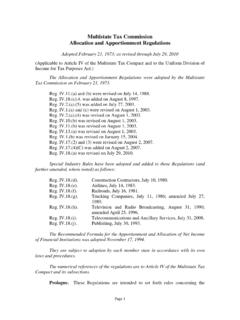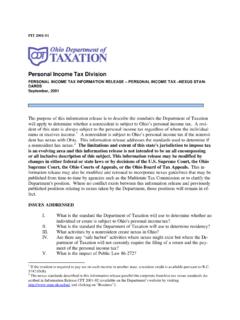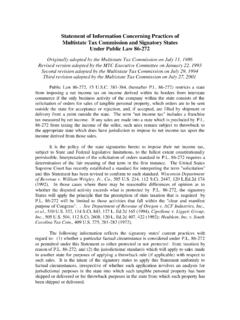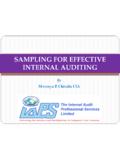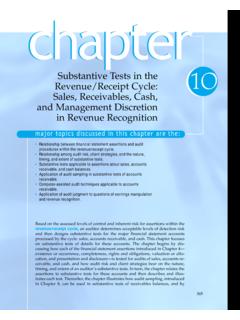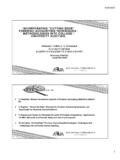Transcription of NON-STATISTICAL SAMPLING GUIDELINES - mtc.gov
1 STATE OF LOUISIANA Department of Revenue NON-STATISTICAL SAMPLING GUIDELINES Effective: 7/9/2009 Page 1 of 33 NON-STATISTICAL SAMPLING GUIDELINES TABLE OF CONTENTS Introduction 1 What is SAMPLING ? 1 Why Sample? 1 Louisiana SAMPLING Law 2 Generally Recognized SAMPLING Techniques 2 Pre-Planning / Pre- audit 3 Define audit Objective 3 Determine Feasibility of a Sample audit 3 Sample Planning and Process 4 Establish Controls Data Integrity Tests 4 Define the Population 5 Identify the SAMPLING Unit 6 Determine Type of Sample 6 Stratified Random SAMPLING 6 Transaction SAMPLING 7 Cluster SAMPLING 7 Block SAMPLING (Time Period SAMPLING )
2 7 Determine Sample Size 7 Choose Method of Selecting Sample Units 10 Judgment SAMPLING 10 Random Selection 10 Systematic Random Selection 11 Evaluate the Sample 12 Prepare the SAMPLING Agreement 12 Examine the Sample Transactions 13 Special Situations / Decision Rules 14 Sample vs.
3 Estimate 16 Calculate the Results 16 Sample Documentation 17 Conclusion 18 Glossary of SAMPLING Terms 19 Appendix 1 Act 201 Louisiana SAMPLING Law 20 Appendix 2 Act 104 Electronic Records 21 Appendix 3 Generally Accepted Auditing Standards 22 Appendix 4 Example SAMPLING Agreement 23 Appendix 5 SAMPLING Plan for Non-Stratified Sample audit 25 7/9/2009 Page 2 of 33 NON-STATISTICAL SAMPLING GUIDELINES LOUISIANA DEPARTMENT OF REVENUE NON-STATISTICAL SAMPLING GUIDELINES INTRODUCTION The purpose of this paper is to provide the audit staff with GUIDELINES in performing a sales and use tax audit using SAMPLING procedures.
4 It will assist the auditor in determining whether a sample audit is feasible, what to consider in making a decision about the type of sample, and discusses some of the aspects of performing sample audits. The law relating to SAMPLING is also covered. This is not intended to be a training manual where all eventualities of SAMPLING are covered. There is no intention to establish rigid rules; rather, these GUIDELINES will set forth general goals for SAMPLING and will allow the auditor discretion in the implementation of an appropriate SAMPLING plan.
5 A separate document will define in detail the department s policy on stratified random SAMPLING and the use of computer assisted audit techniques (CAATs). WHAT IS SAMPLING ? audit SAMPLING is the application of an audit procedure to less than 100% of the transactions within a particular population for the purpose of drawing a conclusion about the entire population. There are two general approaches to SAMPLING : NON-STATISTICAL and statistical . Both approaches require that the auditor use professional judgment in planning, performing, and evaluating a sample.
6 This guideline applies to NON-STATISTICAL SAMPLING . The primary difference between NON-STATISTICAL and statistical SAMPLING is that NON-STATISTICAL SAMPLING relies more on the auditor s judgment while statistical SAMPLING relies on quantitative measurements to determine the SAMPLING risk. SAMPLING risk is the chance that the sample audit findings are significantly different from the amount that would be attained had every item in the population been tested. SAMPLING risk is inevitable whenever less than 100% of the population is examined.
7 Good SAMPLING procedures are designed to reduce SAMPLING risk. WHY SAMPLE? Sales and use taxes are transaction taxes, meaning that tax is determined on a transaction-by-transaction basis. Therefore, verification must be done at the source document level. Since in many cases it is economically impractical to audit all transactions, the department encourages the use of SAMPLING whenever feasible. SAMPLING allows the auditor to reach conclusions about a large amount of data (the population) by collecting and examining a portion of the data (a sample).
8 More time can be spent examining NON-STATISTICAL SAMPLING GUIDELINES DRAFT @ 7/04 - 1 NON-STATISTICAL SAMPLING GUIDELINES each item in a sample than if every item in the population is examined. It also allows for increased audit coverage by allowing the auditor to perform more audits. SAMPLING is necessary when the volume of transactions is so large that a detailed examination of all transactions is not practical. SAMPLING is a more efficient use of time for the department and the taxpayer. There is a reduction in audit hours and document retrieval by both the department and the taxpayer.
9 It allows the auditor to determine, with the least possible expenditure of time for both the taxpayer and the department, the accuracy of reported tax. LOUISIANA S SAMPLING LAW Though the department has always used some form of SAMPLING in the audit process, in 2001 the statute at 47:1541 was amended by the Louisiana legislature to authorize the secretary to use auditing methods which use SAMPLING for the purpose of projecting audit findings when the taxpayer and the secretary agree to this method of audit . 47:1541(C)(2) states, The SAMPLING procedure used shall produce a sample which shall reflect as nearly as possible the normal conditions under which the business was operated during the period to which the audit applies.
10 If either the taxpayer or the secretary can demonstrate that a transaction in a sample for a particular time period is not representative of the taxpayer s business operations during that time period, the transaction shall be eliminated from the sample and shall be separately determined in the audit . The statute states that the taxpayer must be notified of the SAMPLING procedures. It also states that generally recognized SAMPLING techniques must be followed as set forth by the aicpa . Act No. 201 became effective May 31, 2001. See Appendix 1 for a copy of Act No 201.
